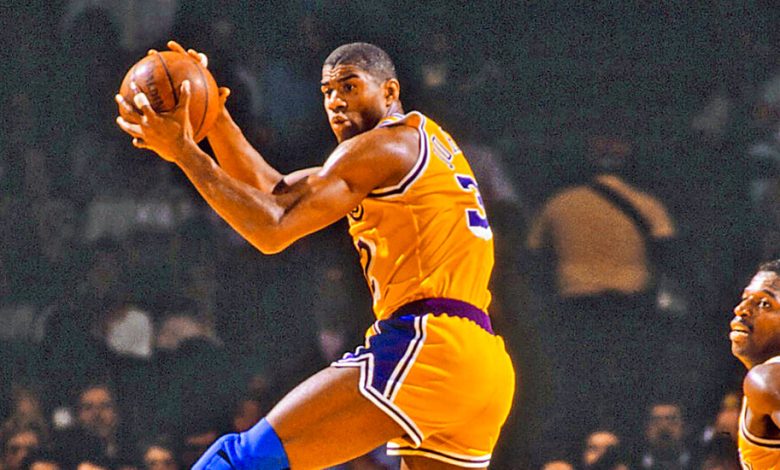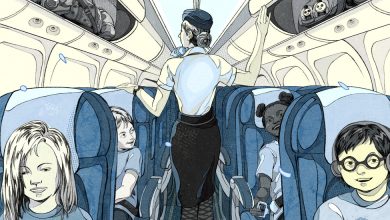Magic Man: The Story of the Greatest Point Guard in N.B.A. History

MAGIC: The Life of Earvin “Magic” Johnson, by Roland Lazenby
I once asked a portrait photographer why no one ever smiled in her pictures, and she replied, “A smile is a mask.”
I thought of this aphorism as I read Roland Lazenby’s 800-page biography of Magic Johnson. Sports Illustrated declared his smile to be one of the two greatest smiles of the 20th century. (The other was Louis Armstrong’s.) As Missy Fox, the daughter of his high school coach, says in the book, “That is the one thing he’s always had, that smile.”
This was apparent very early on in Lansing, Mich. “The chuckles and grins for Christine Johnson’s newest baby boy came so often and brought such delight to all who witnessed them that there was no way they could just be attributed to mere gas,” Lazenby writes. Soon enough, it “became the business of nearly everybody to greet him with a funny face or a noise or toss him up and down until he squealed and giggled and cackled.”
Johnson was a lanky child, remarkably coordinated and obsessed with basketball. He was six feet at the start of seventh grade, 6-foot-5 at the start of 10th. “He would often spend his summer days lost in the game and deliriously happy about it.” Yet by junior high school something was amiss. He was behind in his reading, and “those who knew him then have described him as being decidedly inarticulate, a condition mitigated and hidden somewhat by his smile and demeanor.” His reading issues, “defined as dyslexia,” left him “profoundly embarrassed.”
But he had other skills, other passions and agendas. The Johnson children anticipated attending a nearby high school that was “the center of the community.” But the Lansing schools had come up with a plan “to advance racial integration by busing Black students.” The older Johnson siblings were sent across town to Everett High, where they joined a group of about 100 Black students in a school of 2,500 “that was 99 percent white at the time.” The first buses were greeted with rocks.
When it was time for Earvin Johnson to go to Everett, he intuitively knew how to proceed through the delicate matter of playing for a coach whom his brother (and bedmate) hated, biking all the way across Lansing to shoot baskets, unannounced, in the coach’s driveway.
A remark about Johnson’s high school career from Missy Fox, recalling the raucous scene at his games, stands out: “He was having fun at all times. Everything was just so much fun and his getting everybody involved made it more fun. The no-look pass he would like to make, they called it putting on a clinic because he loved to choreograph some wild plays.”
There is something both breathless and intimate about her insistence on fun. Like many of the subjects quoted in the book, she is looking back at this history decades later, when a dense mesh of legend and history has enveloped Magic Johnson and Larry Bird and Michael Jordan and the birth of the business and cultural phenomenon that is the N.B.A. Maybe her emphasis on fun is another way of saying that this was the last time Magic Johnson was a private citizen, a kid on a high school team that Lansing cherished, not yet the property of the world.
Perhaps this is true for all transcendent athletes who become public property. But one of the interesting facts in the book is how Jordan, just a few years younger, idolized Magic Johnson, going so far as to coin his own nickname, Magic Mike, and put it on the vanity plate of his car. Think how ferociously private Jordan is compared with Magic. Both of them superstars, among the best ever to play, unquenchable in their will to win, yet one closed off, remote, cold, and the other quite the opposite.
In 2019, when Missy Fox was speaking, who could have imagined the HBO series “Winning Time,” dramatizing Magic’s first years playing for the Lakers, or the four-part documentary about Magic on Apple TV, or the ever-heightening obsession with Jordan, such that a major motion picture, “Air,” was built around his shoe deal. (Jordan’s getting royalties on his shoes was a source of vexation for Magic and the entire league, at the time.) “The Last Dance,” about Jordan and the Bulls, appeared in 2020, at the dawn of those pandemic months without N.B.A. basketball, when even the ancient Dream Team documentary from 1992 became must viewing. The episodes Fox describes are removed by only a year or two from Johnson’s two years at Michigan State, which is when his impact, in tandem with Bird’s, began to be felt nationally.
Lazenby (the author of previous books about the Lakers) includes an anecdote about NBC’s announcers, Billy Packer and Al McGuire, preparing for the 1979 championship game pitting Bird’s Indiana State against Michigan State. Don Ohlmeyer, the executive producer, was late showing up to the production meeting, and when he asked to be caught up on the ideas for the pregame show, which focused on the teams and the coaches and the schools, he responded: “That’s the dumbest damn thing I’ve ever heard of. You guys have no damn clue what you’re talking about. The real story about this game is going to be Bird and Johnson. It’s going to be part of basketball history.”
“At the time,” Lazenby notes, “there was not a single major national highlight show in American sports television.”
The curious thing about this compendious, scrupulously researched biography, so rich in basketball and cultural lore, is that the best parts are not about basketball at all. The many pages devoted to accounts of games are the least compelling aspect of the book. What “Magic” gives us is a wealth of detail, a huge cast of characters and, in a way, the tapestry of our time as illustrated by this supremely talented and beguiling figure.
During the press blitz for that N.C.A.A. tournament, Johnson remarked on how much he loved basketball, never tired of it. “Everyone else, including the girls, has to realize that basketball comes first in my life.”
About the girls: Lazenby gives the bacchanal that ensued in Los Angeles as much attention as it deserves, which is a lot. Terms like “satyriasis” and “compulsive sexual behavior” are considered. Mae West is invoked. We learn of his code, “refusing on game days to engage until after the game, then gorging on it,” which sounds a lot like an alcoholic waiting until 5 p.m. to have a drink. We hear of women bribing hotel employees so that they may be seated naked on the bed when he arrives in his room. We hear of unprotected sex. During one training camp, a group of Lakers players and staffers discuss the possibility of Johnson’s developing AIDS. They conclude, “If he doesn’t have it, you can’t get it.”
When the diagnosis of H.I.V. came in 1991, it was widely understood to be a death sentence. Magic turned this setback into something of a positive, joining President George H.W. Bush’s commission on AIDS, becoming a spokesman for people with H.I.V. The details of his falling-out with Isiah Thomas, and Thomas’s suspected role in rumors about how Johnson may have contracted it, are melodramatic but also painful, the ending of what had been a genuine friendship.
The last part of Magic’s career is handled with relative circumspection, though there is a compelling scene illustrating Magic as budding tycoon, pitching Peter Guber, the chairman of Sony Pictures, on a community that loves movies but has no good movie theaters. Guber wants to know where this Shangri-La of untapped markets is, and Magic strings it along until the big reveal: “It’s 15 minutes from here,” he says, in South L.A. “That and 30 more places in America where the African American community is completely underserved.” Guber’s response could stand in for that of many people who have encountered Johnson: “Wow.”
In the acknowledgments, we learn that people close to Magic spoke at length on the record, but that he was not interviewed directly. Magic kept putting it off and, in the end, declined. He was, it turns out, producing a documentary about himself.
MAGIC: The Life of Earvin “Magic” Johnson | By Roland Lazenby | Celadon Books | 813 pp. | $40




